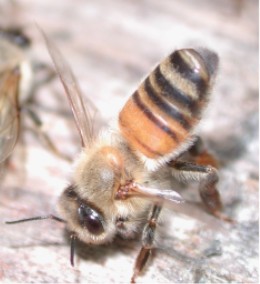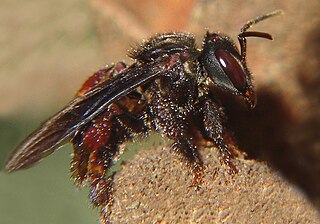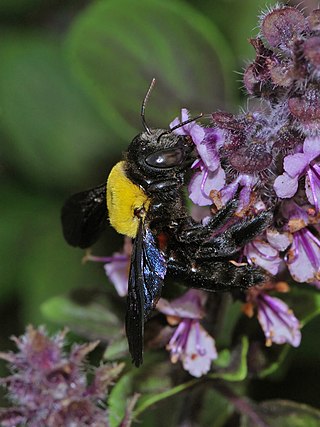
A honey bee is a eusocial flying insect within the genus Apis of the bee clade, all native to mainland Afro-Eurasia. After bees spread naturally throughout Africa and Eurasia, humans became responsible for the current cosmopolitan distribution of honey bees, introducing multiple subspecies into South America, North America, and Australia.

Karl Ritter von Frisch, was a German-Austrian ethologist who received the Nobel Prize in Physiology or Medicine in 1973, along with Nikolaas Tinbergen and Konrad Lorenz.

A bumblebee is any of over 250 species in the genus Bombus, part of Apidae, one of the bee families. This genus is the only extant group in the tribe Bombini, though a few extinct related genera are known from fossils. They are found primarily in higher altitudes or latitudes in the Northern Hemisphere, although they are also found in South America, where a few lowland tropical species have been identified. European bumblebees have also been introduced to New Zealand and Tasmania. Female bumblebees can sting repeatedly, but generally ignore humans and other animals.

Bee learning and communication includes cognitive and sensory processes in all kinds of bees, that is the insects in the seven families making up the clade Anthophila. Some species have been studied more extensively than others, in particular Apis mellifera, or European honey bee. Color learning has also been studied in bumblebees.

A stinger is a sharp organ found in various animals capable of injecting venom, usually by piercing the epidermis of another animal.

The Nasonovpheromone is released by worker bees to orient returning forager bees back to the colony. To broadcast this scent, bees raise their abdomens, which contain the Nasonov glands, and fan their wings vigorously.

A laying worker bee is a worker bee that lays unfertilized eggs, usually in the absence of a queen bee. Only drones develop from the eggs of laying worker bees. A beehive cannot survive with only a laying worker bee.

The East African lowland honey bee is a subspecies of the western honey bee. It is native to central, southern and eastern Africa, though at the southern extreme it is replaced by the Cape honey bee. This subspecies has been determined to constitute one part of the ancestry of the Africanized bees spreading through North and South America.

Bombus lapidarius is a species of bumblebee in the subgenus Melanobombus. Commonly known as the red-tailed bumblebee, B. lapidarius can be found throughout much of Central Europe. Known for its distinctive black and red body, this social bee is important in pollination.

The western honey bee or European honey bee is the most common of the 7–12 species of honey bees worldwide. The genus name Apis is Latin for "bee", and mellifera is the Latin for "honey-bearing" or "honey carrying", referring to the species' production of honey.

Trigona spinipes is a species of stingless bee. It occurs in Brazil, where it is called arapuá, aripuá, irapuá, japurá or abelha-cachorro ("dog-bee"). The species name means "spiny feet" in Latin. Trigona spinipes builds its nest on trees, out of mud, resin, wax, and assorted debris, including dung. Therefore, its honey is not fit for consumption, even though it is reputed to be of good quality by itself, and is used in folk medicine. Colonies may have from 5,000 to over 100,000 workers.

Hair-pencils and coremata are pheromone signaling structures present in lepidopteran males. Males use hair-pencils in courtship behaviors with females. The pheromones they excrete serve as both aphrodisiacs and tranquilizers to females as well as repellents to conspecific males. Hair-pencil glands are stored inside the male until courtship begins, at which point they are forced out of the body by sclerotized levers present on the abdomen. Coremata are very similar structures. Their exact definition is confused by early descriptions but they are more specifically defined as the internal, glandular, eversible structures that bear the hair-pencils and can be voluntarily inflated with hemolymph or air.

Bumblebees, like the honeybee collect nectar and pollen from flowers and store them for food. Many individuals must be recruited to forage for food to provide for the hive. Some bee species have highly developed ways of communicating with each other about the location and quality of food resources ranging from physical to chemical displays.

Bombus frigidus, the frigid bumblebee, is a rare species of bumblebee largely found in Canada and parts of the United States.
Queen mandibular pheromone, or QMP, is a honey bee pheromone produced by the queen and fed to her attendants who share it with the rest of the colony that gives the colony the sense of belonging to the queen. Newly emerged queens produce very little QMP. By the sixth day they are producing enough to attract drones for mating. A laying queen makes twice that amount. Lack of QMP seems to attract robber bees. A study of foraging worker bees has suggested that foraging bees are not attracted to QMP.

Trigona corvina is a species of stingless bee that lives primarily in Central and South America. In Panama, they are sometimes known as zagañas. They live in protective nests high in the trees, but they can be extremely aggressive and territorial over their resources. They use their pheromones to protect their food sources and to signal their location to nest mates. This black stingless bees of the tribe Meliponini can be parasitic toward citrus trees but also helpful for crop pollination.

Xylocopa pubescens is a species of large carpenter bee. Females form nests by excavation with their mandibles, often in dead or soft wood. X. pubescens is commonly found in areas extending from India to Northeast and West Africa. It must reside in these warm climates because it requires a minimum ambient temperature of 18 °C (64 °F) in order to forage.

Scent rubbing is a behavior where a mammal rubs its body against an object in their environment, sometimes in ones covered with strongly odored substances. It is typically shown in carnivores, although many mammals exhibit this behavior. Lowering shoulders, collapsing the forelegs, pushing forward and rubbing the chin, temples, neck, or back is how this act is performed. A variety of different odors can elicit this behavior including feces, vomit, fresh or decaying meat, insecticide, urine, repellent, ashes, human food and so on. Scent rubbing can be produced by an animal smelling novel odors, which include manufactured smells such as perfume or motor oil and carnivore smells including feces and food smells.
Chemical communication in insects is social signalling between insects of the same or different species, using chemicals. These chemicals may be volatile, to be detected at a distance by other insects' sense of smell, or non-volatile, to be detected on an insect's cuticle by other insects' sense of taste. Many of these chemicals are pheromones, acting like hormones outside the body.
















